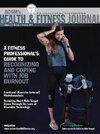PHYSICAL ACTIVITY PROGRAMMING FOR CLIENTS WITH OBESITY: Considerations for Exercise Professionals
A. Dikareva, R. Andersen
下载PDF
{"title":"PHYSICAL ACTIVITY PROGRAMMING FOR CLIENTS WITH OBESITY: Considerations for Exercise Professionals","authors":"A. Dikareva, R. Andersen","doi":"10.1249/fit.0000000000000218","DOIUrl":null,"url":null,"abstract":"Copyright © 2016 American C lthough the prevalence of obesity in North America has plateaued, the proportion of adults living with obesity (body mass index [BMI] ≥ 30 kg/m) 2 A severe obesity (BMI ≥ 40 kg/m ) remains high (46). It is well documented that regular physical activity (PA) is an important habit to prevent unhealthy weight gain and various conditions such as Type 2 diabetes, hypertension, and cardiovascular disease. Importantly, the cardioprotective effects of PA are so potent that habitual PA has been shown to significantly attenuate the risk of mortality and morbidity irrespective of weight and blood pressure status (14,28,43). Given that PA confers innumerable health benefits, improving long-term adoption of regular PA, rather than weight loss, should be at the forefront of health promotion, clinical practice, and policy. So much so that renowned exercise scientist, Dr. Steven Blair, noted in his 2004 editorial in The Journal of the American Medical Association that “the ‘fitness vs. fatness’ debate [is] largely academic” and went on to urge “physicians, researchers, and policymakers [to] spend less energy debating the relative health importance of fitness and obesity andmore time focusing on how to get sedentary individuals to become active” (3). Current data on PA habits of North Americans point to an unfortunate reality: most adults do not meet the recommended PA guidelines of 150 minutes of moderate-to-vigorous PA per week minimum (8,19,48). Moreover, individuals living with obesity are less likely to meet PA guidelines compared with individuals in lower weight categories (8,48). Physical inactivity among individuals with obesity is a complex and poorly understood phenomenon. A growing body of evidence suggests that societal antifat attitudes are negatively impacting the uptake of PA-promoting behaviors among adults. Media and cultural misrepresentations of this multifactorial phenotype on reality television shows, such as “The Biggest Loser,”may partially be responsible for cultivating the characterization that people with larger bodies are unhealthy, lazy, and lacking self-discipline (55). Portraying obesity","PeriodicalId":50908,"journal":{"name":"Acsms Health & Fitness Journal","volume":"20 1","pages":"21-27"},"PeriodicalIF":1.6000,"publicationDate":"2016-01-01","publicationTypes":"Journal Article","fieldsOfStudy":null,"isOpenAccess":false,"openAccessPdf":"https://sci-hub-pdf.com/10.1249/fit.0000000000000218","citationCount":"4","resultStr":null,"platform":"Semanticscholar","paperid":null,"PeriodicalName":"Acsms Health & Fitness Journal","FirstCategoryId":"3","ListUrlMain":"https://doi.org/10.1249/fit.0000000000000218","RegionNum":4,"RegionCategory":"医学","ArticlePicture":[],"TitleCN":null,"AbstractTextCN":null,"PMCID":null,"EPubDate":"","PubModel":"","JCR":"Q3","JCRName":"SPORT SCIENCES","Score":null,"Total":0}
引用次数: 4
引用
批量引用
Abstract
Copyright © 2016 American C lthough the prevalence of obesity in North America has plateaued, the proportion of adults living with obesity (body mass index [BMI] ≥ 30 kg/m) 2 A severe obesity (BMI ≥ 40 kg/m ) remains high (46). It is well documented that regular physical activity (PA) is an important habit to prevent unhealthy weight gain and various conditions such as Type 2 diabetes, hypertension, and cardiovascular disease. Importantly, the cardioprotective effects of PA are so potent that habitual PA has been shown to significantly attenuate the risk of mortality and morbidity irrespective of weight and blood pressure status (14,28,43). Given that PA confers innumerable health benefits, improving long-term adoption of regular PA, rather than weight loss, should be at the forefront of health promotion, clinical practice, and policy. So much so that renowned exercise scientist, Dr. Steven Blair, noted in his 2004 editorial in The Journal of the American Medical Association that “the ‘fitness vs. fatness’ debate [is] largely academic” and went on to urge “physicians, researchers, and policymakers [to] spend less energy debating the relative health importance of fitness and obesity andmore time focusing on how to get sedentary individuals to become active” (3). Current data on PA habits of North Americans point to an unfortunate reality: most adults do not meet the recommended PA guidelines of 150 minutes of moderate-to-vigorous PA per week minimum (8,19,48). Moreover, individuals living with obesity are less likely to meet PA guidelines compared with individuals in lower weight categories (8,48). Physical inactivity among individuals with obesity is a complex and poorly understood phenomenon. A growing body of evidence suggests that societal antifat attitudes are negatively impacting the uptake of PA-promoting behaviors among adults. Media and cultural misrepresentations of this multifactorial phenotype on reality television shows, such as “The Biggest Loser,”may partially be responsible for cultivating the characterization that people with larger bodies are unhealthy, lazy, and lacking self-discipline (55). Portraying obesity
肥胖客户的体育活动规划:运动专业人士的考虑
版权所有©2016 American C虽然北美的肥胖患病率已经趋于稳定,但成年人肥胖(体重指数[BMI]≥30 kg/m)的比例仍然很高(46)。有充分的证据表明,有规律的体育活动(PA)是预防不健康体重增加和各种疾病(如2型糖尿病、高血压和心血管疾病)的重要习惯。重要的是,PA的心脏保护作用是如此强大,习惯性PA已被证明可以显著降低死亡率和发病率的风险,而不考虑体重和血压状况(14,28,43)。鉴于PA带来了无数的健康益处,改善长期定期PA的采用,而不是减肥,应该是健康促进、临床实践和政策的前沿。因此,著名的运动科学家史蒂文·布莱尔博士在2004年《美国医学会杂志》的社论中指出,“‘健身vs肥胖’的争论在很大程度上是学术性的”,并继续敦促“医生、研究人员、政策制定者[应该]少花精力讨论健身和肥胖对健康的相对重要性,多花时间关注如何让久坐不动的人变得活跃起来”(3)。目前关于北美人健身习惯的数据指出了一个不幸的现实:大多数成年人没有达到推荐的健身指南,即每周至少进行150分钟的中等至高强度的健身(8,19,48)。此外,与体重较轻的个体相比,肥胖个体更不可能满足PA指南(8,48)。肥胖患者缺乏身体活动是一个复杂而又鲜为人知的现象。越来越多的证据表明,社会反肥胖的态度对成年人中促进pa行为的吸收产生了负面影响。媒体和文化在电视真人秀节目中对这种多因素表现型的歪曲,如“最大的失败者”,可能部分地造成了人们对体型较大的人不健康、懒惰和缺乏自律的塑造(55)。描述肥胖
本文章由计算机程序翻译,如有差异,请以英文原文为准。


